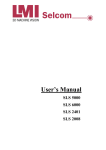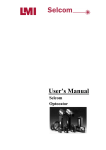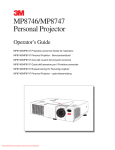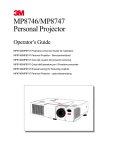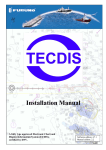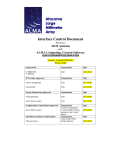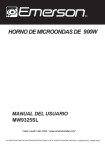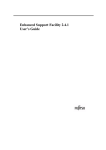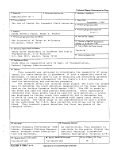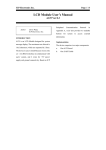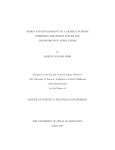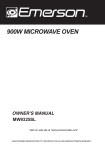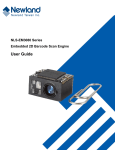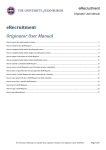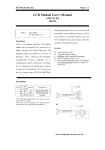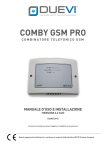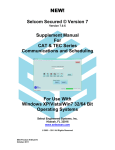Download User`s Manual - FLW of PA, Inc
Transcript
User’s Manual SLS 5000 SLS 6000 SLS 2401 SLS 2008 Table of contents 1 INTRODUCTION 3 2 TECHNICAL DESCRIPTION Identification of parts SLS5000 SLS 6000 SLS 2401 SLS 2008 Manufacturers serial number label Measurement principle and definitions Sampling frequency and bandwidth. The analog position sensitive detector Linearization 4 4 4 4 5 5 6 7 8 8 9 3 TECHNICAL DATA Block diagram Dimensions Environmental conditions Power requirements Performance Sensor configuration SLS5000 SLS6000 SLS2401 SLS2008 Analog Output Digital Outputs RS232-C Selcom serial synchronous interface RS422 Invalid output 9 9 10 10 10 10 11 11 11 12 12 12 13 13 13 14 14 4 SAFETY REQUIREMENT Symbols Safety precautions Summary of user precautions regarding laser Emission delay Safety of Laser products. Maximum Permissible Exposures (MPEs) Laser product classification. Calculation of MPE and NOHD MPE NOHD Warning labels Laser Safety References 03-09-05 1 15 15 15 16 16 17 17 17 18 18 18 19 20 5 INSTALLATION Cable requirements Analog output Scale factor current output and engineering units Load conditions for analog output. Alternative connections for valid output Cable crosstalk. Electrical installations, examples Mechanical installation. For a single SLS sensor system For a dual SLS sensor system Hints for measurements Material Unstable thickness reading Surface texture. Static texture error Temperature of the material Geometry of the material. Secondary reflections 6 SERVICE AND MAINTENANCE Keeping the front glass clean Visual check for damage LED-indicators (Yellow and Green) 21 21 22 22 25 25 26 27 29 30 30 32 33 35 35 37 37 38 38 38 39 7 APPENDIXES Appendix A, Revision page Appendix B, Accessories Appendix C, SLS-asynch-1, protocol Appendix D, SLS power unit 24 Appendix E, Connection table Appendix F, Quality Record Appendix G, Dimensional drawings LMI Technologies AB Ögärdesvägen 19 A Box 250, S-43325 Partille SWEDEN Tel: +46 (0)31 336 25 10 Main +46 (0)31 336 25 00 Fax: +46 (0)31 44 61 79 Internet: http://www.lmint.com 03-09-05 LMI Technologies (USA), Inc. 21455 Melrose Ave. Suite 22 SOUTHFIELD MI 48075 USA Tel: +1 248 355 5900 Fax: +1 248 355 3283 40 40 40 40 51 53 54 57 LMI Technologies BV Valkenburgweg 223 6419 AT Heerlen The Netherlands Tel: +31 45 850 7000 Fax: ++31 45 574 2500 LMI Technologies Inc. 205-7088 Ventura Street Delta, BC, V4G-1H5 Canada Tel: +1 604-940 0141 Fax: +1 604-940 0793 Printed in The Netherlands 2 1 INTRODUCTION This manual is a description of the Selcom Laser Sensor (SLS) family. The sensors have laser classification 2, 3R or 3B. Read chapter Laser Safety precautions before connecting the sensor. This sensor is intended for use in applications where distance, thickness or level is to be measured. The ambient temperature surrounding the sensor should be 0°C to 50°C but the temperature of the measured object may vary from deep frozen to +1600°C. The sensor is equipped with a temperature guard that shuts the laser off should the surrounding temperature exceed the limits. No changes or modifications may be made to the sensor or its cable unless you have a written permission from LMI Technologies. If the sensor is opened or modified without permission, warranty is voided. Caution- Use of controls or adjustments or performance of procedures other than those specified herein may result in hazardous radiation exposure. For your own safety, follow the instructions in this manual. If you get problems when using the SLS sensor, contact your local LMI Technologies office or your local distributor. The delivery of a SLS 5000 contains: • • • SLS 5000 sensor Isolation washers 8 pcs Users manual 1 pcs The delivery of a SLS 6000 contains: • • • SLS 6000 sensor Isolation washers 4 pcs Users manual 1 pcs The delivery of a SLS 2401 contains: • • • SLS 2401 sensor head and SLS Controller Isolation washers 4 pcs Users manual 1 pcs The delivery of a SLS 2008 contains: • • • 03-09-05 SLS 2008 sensor head and SLS Controller Isolation washers Users manual 1 pcs 3 2 TECHNICAL DESCRIPTION Identification of parts SLS5000 Emission indicator device 1, Illuminated when power is ON 2, Green when target is within the measurment range 3, Yellow when no target is present within the measurment range Manufacturers serial number label Laser shutter SELCOM SLS5000 Laser emitting lable Laser aperture Receiver aperture Front glass Mounting holes Side view Front view Figure 1: Identification of parts SLS 5000 SLS 6000 Laser emitting label Air purge inlet Mounting Holes M8 (4X), top mount DANGER Laser Class 3B Selcom LASER MEASUREMENTS SLS 6000 Emission indicator: 1.Illuminated when power is on 2. GREEN when target is within the measurement range. 3. YELLOW when no target is present within the measurement range. Laser aperture, incl laser shutter Receiver Aperture Figure 2:SLS 6000 03-09-05 4 Manufactures serial number label SLS 2401 Emission indicator on 2401 head is RED when laser is ON. Function of Emission Indicator on SLS controller see previous page Figure 3. SLS 2401. SLS controller top and 2401 head bottom. SLS 2008 Emission indicator on SLS2008 sensor head is RED when laser is ON. Figure 4. SLS controller 03-09-05 5 Figure 5. SLS2008 sensor head Manufacturers serial number label Selcom 1 2 BOX 250 S-433 25 PARTILLE SWEDEN 810555 SLS2070/200-WO PART NO 4 345 SN 6 3 TYPE 5 0-20 mA OUTPUT MANUFACTURED: NOVEMBER MONTH 8 1996 YEAR 7 Figure 3: Manufacturers serial number label The serial number label contains the following information: 1. The address of the production location. 2. The part number of the product. Refer to this part number when contacting LMI Technologies. 3. Type description of the sensor. SLS5070/200-BM means: SLS5000 Measurement Range = 70 mm Stand Off = 200 mm Optimized for Building Material (BM) applications Other applications are: MM = Molten metal RO = Road RU = Rubber SW = Saw mill 03-09-05 6 Other letter combinations may occur. 4 Serial number of the sensor. Refer to this serial number when contacting LMI Technologies. 5 Available outputs, one analog and one digital. The outputs are selected when ordering the sensor. Possible combinations are: 0-20 mA / Selcom or 4-20 mA / Selcom 0-20 mA / RS422 or 4-20 mA / RS422 RS232 is always available, ref to appendix for details. 6 Month of manufacture. 7 Year of manufacturer 8 CE-mark. Indicates that the product fulfills the emc-directive according to EN 89/336/EEC Measurement principle and definitions The SLS sensors consist of a light source and a detector integrated with optics and electronics. The light source is a semi conductor laser diode operating in a pulsed mode with 50% duty cycle. The pulse rate or frequency is 16 000 times per second. This laser diode illuminates a spot on the surface of the object to be measured, (log, car body, gypsum board etc.). The spot is not only detectable to the human eye but also clearly visible to the detector of the SLS. The detector is situated at the back of the receiver part, similar to the retina of the human eye. PSD (Position Sensitive photo Detector) Semiconductor laser and optics Receiver optics Stand Off Distance, SO Close End, CE Measurement Range, MR Far End, FE Figure 4: Measurement principle and definitions Depending of the distance between the SLS sensor and the light spot, the Stand Off distance, the image of the light spot will be focused on a certain spot on the detector. The detector is a high resolution, position sensitive detector. It converts the light spot to electrical signals from which the electronics can calculate the actual distance to the object. ”Moving objects, no problem” The measurement is very rapid. The SLS sensor repeats the measurement sequence 16000 times per second. This makes it possible to measure moving and vibrating objects. By using several SLS sensors you can measure thickness, profiles, diameter, etc. 03-09-05 7 The accuracy is high; the error is normally less than 0.2% of the measurement range. Sampling frequency and bandwidth. Sampling frequency and bandwidth are related but not identical quantities. The sampling frequency tells how often the sensor evaluates the raw analog signal by performing an A/D conversion. The bandwidth value tells how that analog signal is conditioned before the A/D conversion. In order to avoid certain signal processing problems, the bandwidth has to be lower than the sampling frequency (it may not exceed 50% of the sampling frequency), and for that reason the signal is put through an analog filter stage before the A/D conversion. Although it is not a theoretically correct way to express it, one might say that the bandwidth determines how fast a measurement signal may change, and have the change detected by the sensor. The analog position sensitive detector Incoming light I1 I2 1 2 0 X Light spot Typical size of the detector is 1*10 mm Figure 5: The analog position sensitive detector The detector current, generated by the light spot is divided into two parts: I1 and I2. The distances between the light spot and the electrodes 1 and 2 give the ratio between the currents. 2.1.1.1 Advantages Advantages: 1 Fast. Rise time 10-90 % (typical) = 0.2 µsec. 2 High suppression of ambient light. 3 Very high resolution. Limited only by the following Analogue-to-Digital converter. The technique also enables fast regulation of the output laser power. This fast regulation makes measurement of almost any material or surface possible and allows for fast and big variations of measured surfaces color and reflectiveness. 03-09-05 8 Linearization SELCOM Detector output SLS5000 Non-linearized function Desired function A small portion of the scattered light Scattered light reflection The function between the raw output from the detector and the actual distance between the SLS sensor and the measured object is non-linear. This non-linearity is mainly due to the geometry of this type of measurements and to the analog portion of the data processing. Therefore each sensor is factory calibrated to compensate for any non-linearity or other built-in error. Using a moving target and a reference scale a translation table is constructed and stored in non-volatile memory inside the sensor. Figure 6: Illustration of linearization 3 Technical data Block diagram Principal diagram: Laser driver Control logic x1+x2 x1 Laser diode Preamplifier A/D-conv. DSP x1-x2 x2 Internal data bus PSD Host processor Power regulator + 24 VDC Figure 7: Principal diagram 03-09-05 9 Interface Dimensions SLS5000 Length: Height: Width: Weight: SLS6000 Length: Height: Width: Weight: 135 mm 105 mm 51 mm 1.1 kg (5.3 inches) (4.1 inches) (2.0 inches) (2.2 lbs) 376 mm 169 mm 70 mm 4.4 kg (14.8 inches) (6.6 inches) (2.7 inches) (9.9 lbs) Environmental conditions Temperature: Operating: 0-50 °C (32-120 °F) Storage: -30-70 °C (-20-160 °F) Protection class :IP65 (NEMA 4) (Excluding connector) Power requirements Input voltage :+24 VDC (18-32 VDC) Input current: 250 mA at 24 V (350-200 mA for 18 -32 V) Start-up current: typical 1,1 A for 8 ms Performance Resolution 0.025 % of Measurement Range Inaccuracy 0.2 % of Measurement Range (Includes non-linearity and error) Sampling rate 16 kHz Bandwidth Up to 2 kHz depending on configuration settings 03-09-05 10 Sensor configuration Measurement Range (MR), Stand Off (SO), Beam divergence angle SLS5000 MR (mm) SO (mm) Spot size at SO (mm) 6 20 10 20 35 35 70 100 70 150 200 325 400 750 1000 50 50 100 100 100 200 200 200 300 300 300 400 450 600 1250 Beam Resolution (rad) 1 LSB= (um) divergence 0,1 0,1 0,1 0,1 0,1 0,3 0,3 0,3 0,3 0,3 0,3 0,5 0,6 0,8 1,0 0,060 0,060 0,030 0,030 0,030 0,025 0,025 0,025 0,017 0,017 0,017 0,013 0,011 0,008 0,004 1,50 5,00 2,50 5,00 8,75 8,75 17,50 25,00 17,50 37,50 50,00 81,25 100,00 187,50 250,00 SLS6000 MR (mm) SO (mm) Spot size at SO (mm) 50 362 100 175 250 362 510 180 225 375 525 375 575 725 300 550 850 1000 03-09-05 400 480 500 500 500 500 600 738 750 750 750 1000 1000 1000 1250 1250 1250 1250 Beam Resolution divergence (rad) 1 LSB= (um) 0,5 0,6 0,6 0,6 0,6 0,6 0,7 0,7 0,7 0,7 0,8 1,0 1,0 1,0 1,2 1,2 1,2 1,2 0,013 0,010 0,010 0,010 0,010 0,010 0,008 0,007 0,007 0,007 0,007 0,005 0,005 0,005 0,004 0,004 0,004 0,004 11 12,50 90,50 25,00 43,75 62,50 90,50 127,50 45,00 56,25 93,75 131,25 93,75 143,75 181,25 75,00 137,50 212,50 250,00 SLS2401 MR (mm) SO (mm) Spot size at SO (mm) 20 50 50 80 Beam Resolution divergence (rad) 1 LSB= (um) 0,06 0,09 0,060 0,038 5,00 12,50 SLS2008 MR (mm) SO (mm) Spot size at Beam Resolution SO (mm) 1 LSB= divergence (rad) (um) 325 1350 2,0 0,004 81,25 325 1600 2,0 0,003 81,25 325 1800 2,0 0,003 81,25 325 2010 2,0 0,002 81,25 Analog Output Output signal interface: current source external impedance: max cable length: selectable at delivery (see manufacturers serial number label): Far end value: Close end value: Resolution: or 4-20 mA Far end value: Close end value: Resolution: Analog max 500 Ω 100 m 0-20 mA 0 mA 20 mA 4.88 microA/LSB 4 mA 20 mA 3.90 microA/LSB Step function Tc Td time [ms] Figure 8: The step response 03-09-05 Analog output 12 Td = delay time, Tc = time constant Time Error (% of step) Tc 2Tc 3Tc 4 Tc 36 % 13 % 5% 2% External impedance = 500 ΩTd = 200 µs. Tc = 80 µs. (at 2 kHz bandwidth) External impedance = 500 Ω + filter according to appendix C. Td = 300 µs. Tc = 100 µs. (at 1.6 kHz bandwidth) Digital Outputs RS232-C No hardware handshaking Protocol: SLS-ASYNCH-1 Ref: Appendix Optional digital: Selcom serial synchronous interface The ”Selcom” output is a proprietary synchronous serial output. It uses a clock and a data signal; with the clock only running while data is being transmitted. Each data item is 16 bits . The same physical output can also be configured in for serial as RS422. The Selcom serial is a gated clock /inverted clock and data and data inverted according to the figure below. MSB is the most significant bit and C is the “Invalid” bit. Data MSB 11 10 9 8 7 6 5 4 3 2 1 LSB 0 C C Data Clock Clock Figure: Selcom serial synchronous output. Clock rate 16 kHz, gated clock Logical ”1”: C > 0.6 V + C-inv. D > 0.6 V + D-inv. Logical ”0”: C-inv. > 0.6 V + C D-inv. > 0.6 V + D Max. Load : (OH = Output High, OL = Output Low) Voltage: U(OH) > 2.0 V U(OL) < 0.8 V 03-09-05 13 C Current: I(OH) > 40 mA I(OL) < -40 mA or RS422 Full duplex Protocol: Ref: SLS-ASYNCH-1 Appendix E Invalid output 100 ohm Inv.out + Inv.out - Figure 9: Optocoupled Max ratings: VCE 35 V IC 50 mA Rise time 60 µs (typical): Fall time 53 µs (typical): 03-09-05 14 4 SAFETY REQUIREMENT Symbols The following symbol appears in the manual: The symbol identifies conditions or practices that are hazardous Safety precautions The light source of the SLS is a semiconductor laser emitting visible or invisible light. The SLS has a 2, 3R or 3B classification according to IEC 60825-1 Safety of Laser products and complies also with FDA performance standards for laser products except for deviations pursuant to Laser Notice No. 50, dated July 26, 2001. The classification for each sensor is stated on the laser warning labels on the sensor. Make sure that you take the proper precautions for the laser class of the sensor you are using. If you are uncertain of the laser class or if you have questions regarding precautions or laser safety standards, please contact your nearest LMI office. The following safety precautions must be observed when working with the equipment: The emitted light can damage the eye if directly exposed, or if the laser light is reflected by a mirror or any mirror like surface directly into the eye. Follow all warnings and instructions in the manual. Personnel working with or near the SLS must be informed about safety distance, hazardous area and other installation specific hazards. Caution- Use of controls or adjustments or performance of procedures other than those specified herein may result in hazardous radiation exposure. Ensure that the voltage from the power supply matches the specifications for the equipment. If otherwise is not explicitly stated, always disconnect the power supply unit during installation, service and maintenance of the SLS. The power supply unit delivered from LMI Technologies is provided with a key control. Remove this key to prevent that the laser is turned on unintentionally. If possible seal off the hazardous area defined in the Safety distance/ NOHD section to prevent unauthorized personnel from getting exposed to laser light. It is always recommended to follow as many of the precautions as possible irrespective of laser class. 03-09-05 15 Summary of user precautions regarding laser For products with a laser safety class 2, 3R or 3B (See text of IEC 60825-1 for complete precautions, subclause indicated in table): Requirements subclause Class 3B 3R 2 Laser safety Officer, 10.1 Remote interlock, 10.2 Key control 10.3 X For 3R --required only if non visible radiation X Beam attenuator (Laser shutter) 10.4 Emission indicator device X Connect to room or door circuits. Pin no 14 (LASER ON) of the SLS connector can be used for this purpose. Remove key when not in use. Key control is provided when power supply is delivered by LMI Technologies. To conform to safety requirements a key control must be installed. Use pin no 15 (+24 VDC) of the SLS connector to /connect/disconnect the power of the SLS. When in use prevents inadvertent exposure. Provided by LMI Technologies and permanently mounted on the front of the sensor. See chapter 2, figure 1. Warning signs, 10.5 Beam path, 10.6 Specular reflection, 10.7 Eye protection, 10.8 Protective clothing, 10.9 Training, 10.10 X X X (X) Indicates that the laser is energized. Required for 3R only if nonvisible laser. See chapter 2, figure 1. Provided by LMI Technologies and permanently mounted on the side of the sensor. One of the LEDs is always lit. • The yellow LED is lit when the sensor signals Invalid, e.g. no object inside the measurement range, too little light scattered back to the detector, to much light scattered back to the detector. • The green LED is lit when the measurement is Valid Follow precautions on warning signs. X X Terminate beam at the end of its useful length. X X Prevent unintentional reflections X Required if engineering and administrative procedures not practicable and MPE exceeded. Not required X X X Required for all operator and maintenance personnel. Emission delay LMI Technology’s sensors can be equipped with two different types of emission delay. One (called Laser ON delay) will always cause a short delay every time the laser control signal is turned on, before the laser actually starts emitting laser light. The other type (called Power ON delay) will only cause a delay when the sensor is first powered up. All subsequent cycling of the laser control signal will control the laser without any delays. See quality record. 03-09-05 16 Safety of Laser products. Maximum Permissible Exposures (MPEs) IEC 60825-1, Safety of laser products, relies on the concept of the MPEs. The MPEs are derived primarily from animal and human data, but take into account of human variability and laser parameters Clause 3.55 of IEC 60825-1 defines the maximum permissible exposures as “The level of laser radiation to which, under normal circumstances, persons may be exposed without suffering adverse effects. The MPE levels represent the maximum level to which the eye or skin can be exposed without consequential injury immediately after, or after a long time, and are related to the wavelength of the radiation, the pulse duration or exposure time. The tissue at risk and, for visible and near infrared radiation, the size of the retinal image. For calculation of MPE see “Calculation of MPE and NOHD in this manual. Laser product classification. The classification of a laser product is based on the radiation emitted during the normal operation and any reasonable foreseeable fault condition for that product. 4.1.1.1 Class 2 laser products: Class 2 laser products would not cause permanent damage to the eye under reasonable foreseeable conditions of operation, provided that any exposure can be terminated by the blink reflex (assumed to take 0,25 s). Because classification assumes the blink reflex, the wavelength must be in the visible range (400 nm to 700 nm). The Maximum Permissible Exposure (MPE) for visible radiation for 0,25 s is 25 W per square meter, which is equivalent to 1 mW entering an aperture of 7 mm diameter (the assumed size of the pupil). 4.1.1.2 Class 3R laser products Class 3R laser products emits radiation where direct intrabeam viewing is potentially hazardous but the risk is lower than for Class 3B lasers, and fewer manufacturing requirements and control measures for users apply than for Class 3B lasers. 4.1.1.3 Class 3B laser products Class 3B laser products are unsafe for eye exposure. Usually only ocular protection would be required. Diffuse reflections are safe if viewed for less than 10 s. 4.1.1.4 Nominal Ocular Hazard Distance (NOHD) or safety distance. The NOHD is related to the Maximum Permissible Exposure (MPE). The NOHD is the nominal distance at which the exposure equals the MPE. The concept of NOHD is used when laser products such as range finders or display lasers are to be used in the open air. 03-09-05 17 S ta n d O ff SO Irra d ia n c e o r R a d ia n t E x p o s u re e q u a ls M P E B e a m d iv e r g e n c e S L S L aser A p e rtu r e NOHD E x p o s u re d o e s N ot exceed M PE E x p o s u re e x c e e d s M P E The NOHD is depending on Stand Off and working power and can be found in the Quality record that comes with each sensor delivered. See appendix GQuality Record for the actual NOHDof your sensor and actual parameters for your SLS in order to calculate MPE and NOHD. Figure 10: The concept of nominal ocular hazard distance Calculation of MPE and NOHD MPE See section 13 in the IEC80825-1. Parameters necessary to be able to calculate the MPE are exposure time base, max pulse power, wavelength, pulse repetition frequency and pulse duration. These parameters can be found as follows. Parameter Exposure time base Max pulse power, wavelength and pulse duration Pulse repetition frequency Time base for MPE is 10 s for invisible (see example A.4-2 in the IEC 60825-1 ed. 1.2) and for Visible 0,25 s (example A.41). Explanatory label affixed to the product Same as the term “Sampling frequency” found in the Q-record. 16000 Hz for all SLS 4.1.1.5 MPE values for SLS. The MPE values as well as the results of the calculation of each of three requirements of 13.3 in IEC 80625 are stated in the table. Wavelength 13.3 a J/m2 13.3.b J/m2 13.3.c J/m2 Most restrictive J/m2 655 nm (visible) 780 nm (NIR) 7,52E-03 1,09E-02 1,59E-03 9,14E-04 9,46E-04 5,44E-04 9,46E-04 5,44E-04 Most restrictive corresponds to MPE W/m2 30,3 17,4 NOHD See Annex A, section A.5 in the IEC standard and TR 60825-10. Parameters 03-09-05 18 necessary to be able to calculate the NOHD are MPE, max average power, beam divergence, diameter of emergent laser beam (a) and Non Gaussian correction factor. These parameters can be found as follows. Parameter Max average power Beam divergence angle Non Gaussian correction factor MPE Q-record See section “ Sensor configuration” LMI use 2.5. See table above Diameter of emergent laser beam (a) 5 mm The NOHD value for each sensor can be found in the Q-record. Warning labels Products complies with IEC 60825-1 and with FDA performance standards for laser products except for deviations pursuant to Laser Notice No. 50, dated July 26, 2001. The following labels are attached to the sensor:-All languages: Figure 11: Manufacturers serial number label Class 2 03-09-05 19 Class 3R Class 3B Example -Near Infrared laser Figure 10a: Explanatory label, (example English) Figure 10 b: Aperture label Laser Safety References 1 International Standard IEC 60825-1 (2001-08) Consolidated Edition, Safety of laser products - Part 1: Equipment classification, requirements and user's guide 2 Technical Report IEC TR 60825-10, safety of laser products- part10. Application guidelines and explanatory notes to IEC 60825-1 3 Laser Notice No. 50, FDA and CDRH http://www.fda.gov/cdrh/radhealth.html 03-09-05 20 5 INSTALLATION Pin configuration DSUB-15 pin, pin connector 1 ..... ..... ..... CONTACT series R2.5-16 pin, pin connector 12 11 1 15 16 1 Receive data, RS232-C 9 Transmit data, RS232-C 3 CLOCK, SELCOM interface or RS422 Rx+ 4 CLOCK-inv, SELCOM interface or RS422 Rx5 DATA, SELCOM interface or RS422 Tx+ 6 DATA-inv, SELCOM interface or RS422 Tx8 Invalid out-, (when analog interface is used) 12 Invalid out+, (when analog interface is used) 13 Analog out 11 Ground 14 Laser ON, (+24 VDC) 15 Power, (+24 VDC) Figure 12: 15 pin DSUB miniature, pin connector (3 rows) and 16 pin CONTACT series R2.5, pin connector, front views. Note: The DSUBmin connector meets IP50 (NEMA 1). The connector may require extra protection if mounted in a humid environment, although dust alone will not require any added precautions. The CONTACT connector meets IP65 (NEMA 4) when connected with mating connector. The SLS data can only be accessed through the interface that was specified at the time of ordering (see serial number label ”Output”). Cable requirements Cable length Interface Pin number Max cable length RS 232 1, 9, 11 15m RS 422 or Selcom serial 3, 4, 5, 6 100 m Analog 11, 13 100 m (<7.5 Ω/signal lead) Invalid 8, 12 100 m 03-09-05 21 Signal leads with demand for twisted pairs Interface Pin number RxD - GND (RS232) 1, 11 TxD - GND (RS232) 9, 11 CLOCK - CLOCK-inverse 3, 4 DATA - DATA-inverse 5, 6 Rx+ - Rx(RS422) 3, 4 Tx+ - Tx(RS422) 5, 6 Signal leads without demand for twisted pairs Signal lead Pin number Analog out (Current source) 13 Laser ON +24VDC (+5 - +32 14 VDC) Invalid out+ (optocoupled) 12 Invalid out- (optocoupled) 8 Power supply leads Main power. The power supply leads should be dimensioned so that the voltage between pin 15 (+24VDC) and pin 11 (GND) never falls below 18 VDC. For a 24 VDC power source this means that the total resistance in the power and ground leads must not exceed 15 ohms. Laser ON (control input). Pin 14 must be held at +24 VDC (+5 - +32 VDC) to enable the laser. Cable screening The cable shall include a screen connected to GND at the ”sensor end” of the cable. Analog output General considerations The analog current output of the SLS5/6000 sensors is derived from the same high performance and accuracy digital distance data as available over the Selcom Serial, RS232 and RS422 interfaces. The digital information has passed through a high performance digital to analog current converter supplying an easy to acquire signal form for many industrial users and processes. As a complement to the analog output, an ”Invalid out” signal is available. The sensors are available in two versions (factory set, not to be changed by the user!) regarding the state of the analog output when data is considered ”invalid”: ”Hold latest valid” i.e. the analog output current is held at the latest valid D/A converted data value. ”Zero out on invalid” is only available with 4-20 mA output i.e. the analog current output is set to 0 mA as long as data is considered invalid. Scale factor current output and engineering units IMPORTANT: The transformation of the current output to engineering units (i.e. mm, inches etc.) in a control computer, PLC etc. requires the use of a ”scale factor (SFI )” that defines the relation between current output and engineering unit. For a 03-09-05 22 given sensor measurement range the only valid scale factor figure is given in the table Analog current scale factor for SLS It is NOT CORRECT and will lead to erroneous results if the measurement range is simply divided by the current range!! If an absolute distance between the target and the sensor (or some other ref. Point) is to be computed, it is necessary to be aware of the fact that the fixed calibration point between the sensor and the current output is defined at the Stand-Off distance as being 10 mA for a 0-20 mA sensor and 12 mA for a 4-20 mA sensor. Referencing of analog current output to sensor - target distance 4 - 20 mA case D (mm) Far End Stand-off (SO) SO is ”fixed point” for the relation between MR and I Close End 4 12 20 I (mA) Compute distance D (sensor - target): D = (12 - I) * SFI + SO Where: Example: SO = Stand-Off distance i.e. distance from sensor front to MR midpoint SFI = Analog current output scale factor. Expressed as ”mm/mA”. I = Analog current output in mA. D = Measured distance from sensor front to target in mm. Sensor is SLS5200/300 => SFI = 12,8 mm/mA SO = 300 mm D = (12 - 5,5) * 12,8 + 300 = 383,2 mm D D I = 5,5 mA SO (=300mm) 03-09-05 23 0 - 20 mA case D (mm) Far End Stand-off (SO) Close End 0 10 20 I (mA) Compute distance D (sensor - target): D = (10 - I) * SFI + SO Example: Sensor is SLS5325/400 => SFI = 16,64 mm/mA, SO = 400 mm D = (10 - 13,5) * 16,64 + 400 = 341,76 mm D I = 13,5 mA SO (=400mm) Analog current scale factors (SFI) for SLS sensors: MR (mm) 6 10 16 20 35 50 70 100 150 175 200 225 250 300 325 375 525 550 575 03-09-05 0-20 mA SFI (mm/mA) 0,3072 0,512 0,8192 1,024 1,792 2,56 3,584 5,12 7,68 8,96 10,24 11,52 12,8 15,36 16,64 19,2 26,88 28,16 29,44 24 4-20 mA SFI (mm/mA) 0,3840 0.64 1,024 1,28 2,24 3,2 4,48 6,4 9,6 11,2 12,8 14,4 16,0 19,2 20,8 24,0 33,6 35,2 36,8 725 850 1000 37,12 43,52 51,2 46,4 54,4 64,0 Load conditions for analog output. The current output load resistance should not exceed 500 ohms. A return path to ground should be provided via pin 11 (GND). The total resistance in the analog out lead and the ground lead must not exceed 15 ohms. SLS5000 connector 0-20mA + pin 13 max 500 ohm pin 11 0-10 VDC - max 100 meters max 7.5 ohm /signal lead Figure 13: Example of connection: Note: We recommend the use of temperature stable resistors to reduce the effects of voltage variations due to resistance changes. Always turn the power off before connecting or disconnecting the analog output load. Alternative connections for valid output The output transistor conducts as long as the measurement is valid. + 5V V+ SLS2000 100 ohm green I = max 50 mA Valid out yellow Figure 14: Example of connection (current sink): 03-09-05 25 4.7 k ohm LOW = Valid HIGH = Invalid + 5V V+ SLS connector 100 ohm pin 12 I = max 50 mA Valid out LOW = Invalid HIGH = Valid pin 8 4.7 k ohm Figure 15: Example of connection (current source): Cable crosstalk. Due to cable crosstalk the spectral characteristics of the analog current output, as measured over a 100 Ohm resistor, may have the following principal appearance: SLS5000 signal spectrum HF-noise spectrum 1 10 100 kHz Figure 16: Illustration of spectrum The analog output of the SLS sensor mainly finds its use in low bandwidth, industrial measurement and control applications. The signal conversion equipment in such applications is normally band limited to low frequencies making the system insensitive or high frequency noise. For some wide band applications like vibration analysis or when the signal is to be manually studied with an oscilloscope, the high frequency noise may be a problem. In these cases an anti-aliasing filter may be added between the load resistor and the registration equipment. A simple but in most cases sufficient filter is shown below. The components as chosen will give an upper frequency limitation of 1.6 kHz. It is important that the filter and the registration equipment is connected with as short cabling as possible to avoid additional noise pick-up. SLS5000 connector pin 13 I (output) 10 k ohm Load resistor 10 nF pin 11 03-09-05 26 Registration equipment Electrical installations, examples Below are four examples of electrical connections using the available interfaces provided by the SLS sensor: Analog output, 0-20 mA SLS5000 connector User end 8 Invalid out - 12 Invalid out + 11 GND 13 Analog out 14 Laser ON 15 Power (+24 VDC) 4.7 k ohm LOW = Invalid, HIGH = Valid + 24 VDC 10 k ohm 500 ohm 10 nF 0-10 V + 24 VDC Remote control + 24 VDC Key switch Figure 18: Analog output with filtering Selcom synchronous serial interface SLS connector 03-09-05 User end 3 Clock 4 Clock-inverse 5 Data 6 Data-inverse 11 GND 14 Laser ON 15 Power (+24 VDC) Connect to SSP connector J1 or J2, ref to SSP manual. Connect to OIM-II board connector P2, ref to OIM manual. If an OIM-I board is used the Key switch must be provided, ref. fig. 4.4.1. 27 Selcom synchronous serial interfaceRS422 interface SLS c o n n e c to r U ser end 3 R x+ T x+ 4 R x- T x- 5 T x+ 6 T x- R x+ R x- 11 GND 14 Laser O N 15 P o w e r (+ 2 4 V D C ) GND + 24 VDC R e m o te c o n tro l K e y s w itc h + 24 VDC Figure 19: Selcom synchronous serial interfaceRS422 interface RS232 interface SLS connector User end 1 Receive data Transmit data 9 Transmit data Receive data 11 GND GND 14 Laser ON 15 Power (+24 VDC) + 24 VDC Remote control Key switch 03-09-05 28 + 24 VDC Mechanical installation. The SLS sensor must be mounted rigidly in such a way that neither thermal expansion of the fixture nor external forces may influence its position. Otherwise the accuracy of the system will be affected and frequent re calibrations of the system may be necessary. Calibrate the system as often as possible to avoid influence of mechanical fixture drift due to time and temperature. Make sure that the optical path is not obstructed. •1 It is possible during installation that unintentional exposure to laser light may occur take extra care not to look into the laser aperture of the SLS sensor unless you are certain that the laser beam is turned off. Tools that are used during installation may give mirror like reflections. •2 If possible wear protective goggles. •3 The laser beam of the SLS sensor cannot burn skin. Eight plastic mounting washers are enclosed in the delivery. These washers may be used to electrically isolate the sensor from its mounting surface, see figure below. M6 mounting bolts Isolation washers Washers Mounting surface Mounting Surface 7,0 mm Air purge inlet Mounting plate DANGER Laser Class 3B 03-09-05 Bolt (M8) Drill diam. 10.5 - 11.0 mm Isolation washer (4x) Washer (4x) Mounting Holes M8(4x) Selcom LASER MEASUREMENTS SLS 6000 29 For a single SLS sensor system The distance between the SLS sensor and the reference plane must not be changed. 1 1 2 3 Target 4 Reference roller Reference roller Figure 20: Measurement against the reference plane 1. Laser beam 2. If the incoming laser beam is not perpendicular to the measured surface, compensation for the angle may be necessary. 3. Good contact between the reference surface and the measured material is important. 4. Eccentricity of a reference roll may cause variation in the thickness value. Keeping track of the roll while performing multiple calibrations may solve this problem. SLS5000 SLS5000 SLS5000 SLS5000 For a dual SLS sensor system The distance between the two SLS sensors must not be changed, between calibration and measurement. The accuracy of a dual SLS sensor system for thickness measurement is highly dependent on laser beam adjustment of the two sensors. It is necessary to have the two laser beams concentric through the entire measurement range. In the left figure below, the thickness will decrease when the measured object is tilted as in the figure and increase (more than correct) when tilted the other way. In the right figure the thickness of the measured object will increase for any tilt angle. CORRECT WRONG Figure 21: Installation example, dual sensor thickness measurement • • • • • 03-09-05 Useful equipment: IR-viewer. Piece of cardboard paper (about 0.5 x 100 x 100 mm, preferably blue). Piece of non-transparent material (about 5 x 100 x 100 mm, with even thickness). Horizontal spirit level. 30 1. Sensor 1 is mounted in its fixed position. Use the horizontal sprit level. Make sure that the mechanical flap in front of the laser aperture is in the closed position. Sensor 2 Start by making this plane horizontal Sensor 1 Figure 22: Illustration of how to mount the sensor 2 3 4 5 6 7 8 9 10 Sensor 2 should be loosely mounted, not fixed. The sensor should be turned off with the mechanical flap open. Turn sensor 1 on. Cover the receiver aperture of sensor 1 to make the sensor output maximum laser intensity. Open the mechanical flap. Adjust sensor 2. The light spot from sensor 1 must fall on the laser aperture of sensor 2 as concentricity as possible. Turn sensor 1 off and leave the mechanical flap open. Secure the position of sensor 2 (not finally). Cover the receiver aperture of sensor 2 to make the sensor output maximum laser intensity. Turn sensor 2 on. Adjust sensor 2 by tilting it only. The light spot from sensor 2 must fall on the laser aperture of sensor 1 as concentricity as possible. Sensor 2 can be tilted by carefully loosening some bolts and placing thin shims between the SLS sensor and the mounting surface. Turn sensor 2 off. Fix its position finally. Remove the covers for the receiver apertures. The sensors should now be correctly mounted. The following control procedure can be used to verify that an installation is correctly made or to check for mechanical changes in the mounting structure: 1. Cover the receiver apertures of sensor 1 and 2 to make the sensor output maximum laser intensity. 2. Turn sensor 1 and 2 on. 3. Put the piece of cardboard paper in the measurement range. Make sure by moving the paper along the laser beams that they coincide everywhere between the sensors. If an infrared (820 nm) laser is used, the IR-viewer is necessary to see the light spots. A near infrared (780 nm) laser can be seen without the help of an IR-viewer (especially on a blue color). Since the cardboard paper is semi transparent for infrared light, the light control circuits of the two SLS sensors will interfere. This is noted as a variation in the light intensity of the spot on the paper. This phenomenon will 03-09-05 31 not occur when using special designed sensors for semi transparent materials. 4. Remove the cover over the receiver opening. Put the piece of non-transparent material in the measurement range. Try to keep it as perpendicular to the laser beams as possible. If the sensors are correctly aligned you will note an increase of the thickness when you tilt the plate. A decrease of the thickness value is an indication that the sensors are misaligned. Sensor 2 Sensor 1 Sensor 2 Sensor 1 Increase of thickness Increase of thickness Figure 23: Illustration of item 4 above. Avoid set-ups where the two sensors can see each other when they are supposed to measure. A set-up as described in the left figure will produce a variation in the output value at approximately 1 Hz. See semitransparent materials. SLS5000 SLS5000 SLS5000 WRONG SLS5000 CORRECT Figure 24: Dual sensor thickness measurement Hints for measurements The SLS sensor is designed to give a true and dependable measurement for a vast range of materials, surfaces and speed of target/surface. Sensor features: 1 High speed of light power control. 2 Dynamic range of light power output extremely wide 3 Bandwidth of position data from up to 2 kHz. 4 Sampling rate 16 000 times per second. 5 Small laser spot. Some materials or surfaces requires some considerations and advises to get the best possible performance. The target characteristics can be structured into: 1. Material. 03-09-05 32 2. Surface texture. 3. Temperature of the material. 4. The geometry of the material. Material 5.1.1.1 General group. Mat surfaces. There is a bulk of different materials that falls into the general group, i.e. easily measured on for the SLS sensor. Generally these materials have a mat type of surface. Examples from this group are paper, hot rolled steel, concrete, gypsum etc. 5.1.1.2 Fibrous material The obvious example in this group is any kind of wood: logs, sawn boards, parquet blocks, etc. When the laser light meets this type of surface it is spread somewhat along the fibers. The center of gravity of the spot can then move out of the expected position and the result will be an error in the output data. This will occur if the optical triangle is oriented parallel to the direction of the fibers. Top view "The light spot is spread along the fibres" SLS5000 SLS5000 Side view along the board "Optical triangle perpendicular to the fibres" Side view across the board "Optical triangle parallell to the fibres" Figure 25: Fibrous material Advise: Mount the sensor with the optical triangle perpendicular to the direction of the fibers. 5.1.1.3 Shiny materials. Black and shiny materials. Stainless steel, molten metal and other mirror like surfaces. They scatter very little light back to the detector due to the fact that most of the light is reflected according to optical law of reflections. The amount of light scattered in the direction of the receiving lens can vary rapidly over time and with a wide range of magnitude. Black materials scatter only a small part of the incident light. Black materials in combination with a shiny appearance, like fresh extruded rubber or wet asphalt, require a very powerful light control. It is important to use an SLS sensor specially designed for measurement on this type of surface. 03-09-05 33 Black material General group Shiny material Figure 26: Illustration of reflection Advise For extremely shiny materials like molten metal (magnesium with protection gas or coated zinc plates very close to the bath) without any skin or oxide on the surface it may be necessary to tilt the SLS sensor somewhat to get enough light in the direction of the receiving optics consult LMI Technologies. Note that some material ages optically, e.g. car paint or uncured rubber. Compare an absolutely fresh sample from the extruder measured immediately and after 15 minutes a great difference will be noticeable. 5.1.1.4 Transparent materials Transparent materials cannot be measured since no light is scattered on the surface (e.g. glass). Transparent materials like coolant oil or water on a surface will add roughly half the thickness of the oil or water layer (given by the refraction index) to the thickness or position data. Advise: The compensation for the layer thickness is roughly 50% of the actual transparent layer thickness. (For oil and water layers). 5.1.1.5 Semitransparent materials The semitransparent material will scatter enough light to produce a stable measurement, but there will also be a penetration of light into the material and a contribution from internal reflections (as well as background reflections). The result is a position reading that is below the actual surface. The ”offset” value depends on the degree of transparency. In many situations the offset is small and constant and can be calibrated for. A method to measure this offset is to stick a thin strip of adhesive paper to the surface and scan the material (the thickness of a paper is approximately 0.1 mm). Transparent Reflective Figure 27: Light behaviour on transmission material 03-09-05 34 Semi transparent Unstable thickness reading 1 In the case of a dual sensor system, the sensors will receive not only reflected light but also the transmitted light from ”the opposite” SLS sensor. Since they are working at nearly the same frequency, they will interfere with each other. The output from the system will contain a low frequency component (~1 Hz) even if the set up is in steady state. This is an important phenomenon that has to be considered in all dual applications. Note that special designed SLS sensors can be ordered to avoid this phenomenon. Advise 2 Single sensor thickness measurement using a mechanical reference. Offset compensation for penetration can be useful if the material is homogeneous. 3 Dual sensor thickness measurement on semitransparent materials. Use SLS sensors designed for semitransparent materials. Surface texture. Static texture error A basic statement to take care of is that the light spot produced on the target covers a certain area and the SLS sensor will respond to the center of gravity of the image of that spot on the detector. If the spot covers an area that gives an irregular amount of scattered light in the direction of the receiving optics, the SLS sensor reads a position of the surface below or above the true surface. Receiving lense Laser beam Laser beam Black surface White surface Rolled steel Figure 28: Reflection depending on target material The change in the position output depends on the orientation of the sensor. The magnitude and the duration in length depend on the size of the laser spot. As a general rule the spot must be as small as possible. An example of output from the SLS sensor is shown in the figure below. Note that if the SLS sensor is rotated 90 degrees to the orientation indicated, no error spikes occurs. 03-09-05 35 SLS5000 Scan Black strip/spot Position output Figure 29: Example of output from the SLS sensor Surfaces with a regular pattern from machining (e.g. rolling marks or from grinding) will cause a uniform scattered reflection. This will result as a static error that varies depending on where on the machining marks the center of gravity of the light spot is located. Scanning across the marks and averaging the measured data can eliminate this error. FIGURE 2 FIGURE 1A FIGURE 1B Figure 30: Fig. 1 A Fig. 1 B Fig. 2 The regular surface is often produced in a rolling mill and looks like a rib mark structure along the strip. In other words regular thickness variations across the strip. The SLS sensor should be mounted parallel to the ”ribs” and with a scanning direction across the direction of travel. Advise 1 If possible orient the optical triangle parallel to surface irregularities. 03-09-05 2 If possible try to calibrate by letting the laser spot scan over a distance (e.g. 10 mm) of the surface, to eliminate static texture error. 3 Calculate an average over distance when measuring. 36 Temperature of the material Due to the given specification of the SLS sensor it has a maximum temperature coefficient of 200 ppm. That is for the SLS sensor housing temperature. The temperature of the object does not affect the accuracy at all within the given specifications. Advise. The SLS sensor system will measure the actual thickness of the hot material. Be sure to take into account the temperature expansion effect when comparing with other measurements. Geometry of the material. Secondary reflections The SLS sensor position data is given by the center of gravity of laser light on the detector. The laser light must origin from the laser spot on the surface. If laser light scattered from the spot reaches the detector via a secondary reflection that may affect the reading. In most cases the phenomena can be avoided by orienting the SLS sensor according to the figure below. WRONG CORRECT Scan Profiling Figure 31: Sensor orienteering 03-09-05 37 6 SERVICE AND MAINTENANCE It is possible during service and maintenance that unintentional exposure to laser light may occur takes extra care not to look into the laser aperture of the SLS sensor unless you are certain that the laser beam is turned off. Tools that are used during installation may give mirror like reflections. If possible wear protective goggles. The laser beam of the SLS sensor cannot burn skin. No changes or modifications may be made to the sensor or its cable unless you have a written permission from LMI Technologies. If the sensor is opened or modified without permission, warranty is voided. For service, contact the LMI Technologies office closest to your location or your local distributor. It is recommended that the following be performed on a regular basis depending on environmental conditions. Keeping the front glass clean 1.Turn the power OFF. • If LMI Technologies provides the power supply: remove the key. • Other wise: make sure that the power cannot be unintentionally turned on. 2. Wipe the front glass clean using a soft, lint free cloth, if necessary moisten with mild cleaning fluid (e.g. cleaning alcohol). 3. Check the front glass for adherent particles or damage. If damaged, contact your LMI Technologies representative. 4. Turn the power ON. Visual check for damage 1 Turn the power OFF If the power supply is provided by LMI Technologies: remove the key. Other wise: make sure that the power cannot be unintentionally turned on. 1 Check the sensor for mechanical damage. 2 Check the cable for damage. 3 Check that mounting screws/bolts are tightened. 4 Check that any extra accessories are working. 5 Check filters and hoses for air purge. 6 Check calibration block. 7 Turn the power ON. 03-09-05 38 LED-indicators (Yellow and Green) 1 Both LED-OFF Main power to the SLS is OFF, Check the +24 VDC supply. 2 Both LED-ON • Power up and initialization sequence (approximately 10 sec.) • The sensor set-up menu is active (SLS5000 and SLS6000 only, see Appendix E Parameter Setup.) 3 Green LED-ON Laser is ON Object in measurement range (or in a false measurement range, check distance between sensor and object!) Laser spot invisible to the naked human eye 4. Yellow LED-ON • Laser is OFF or • Laser is ON but no object in the measurement range or • Laser is ON with an object in the measurement range Indication that the Laser is faulty, contact LMI Technologies! 5. Yellow and Green LED is blinking Faulty sensor condition, contact LMI Technologies! 03-09-05 39 7 Appendixes Appendix A, Revision page Revision Date Page Description P9.2 00-05-09 Front page Appendix E SLS2400 changed to SLS2401 Non-Volatile Memory information added. P9.3 01-01-09 Section 7 Start up current corrected. Figure added for Selcom synchronous. P9.4 01-01-31 Appendix B Changed to meet the visible red laser P9.5 03-09-05 Section 3 and Appendix sections Laser safety updated section updated. Appendix B, Accessories LMI Technologies can supply the following accessories: • Additional cables • Heat protected cables • Air purge adapter • Power supply • Heat shield (temperatures < 750 °C) Appendix C, SLS-asynch-1, protocol General information Baud rate 9600 baud 38400 baud 8 LSBs Character length Parity Start LSBs None 1 LSB Stop LSBs 1 LSB (RS-232) (RS-422) HW handshake None SW handshake XON/XOFF Max update 50 Hz 03-09-05 (RS-232, ASCII reply mode only) (RS-232, ASCII reply mode) 40 rate 100 Hz 1000 Hz (RS-232, binary reply mode) (RS-422) The SLS sensor always operates as a slave, i.e. it never initiates a data transfer itself. All data transfers must be requested by an external device, referred to in the rest of this document as the master. The master can communicate with the SLS sensor either via RS-232 or RS-422. The RS-422 command set is a subset of the full RS-232 command set. RS-232 commands are always ASCII, whereas RS-422 commands are binary. The output from the SLS may be either ASCII or binary over RS-232 but is always binary over RS-422. Definitions Distance Value Measurement Validity Laser Intensity Sensor Temperature The reply differs with the measurement unit that is used. The actual number of fractional digits (in the case of millimeters or inches) depends on the sensors scale factor. The reply gives the validity of the signal as a percentage of the last 100 samples The reply gives the laser intensity as a percentage of the maximum. The maximum is calibrated when the sensor is manufactured. A command for reading the actual laser power in milliwatts exists in RS232, ASCII reply mode (see section Laser Intensity). The reply gives the temperature in degrees Celsius. It is measured inside the sensor. Conventions The following conventions are used in this document: nnnnn Rrr.rrr 0xXX 0xXXXX 03-09-05 Groups of the letter n stand for integer numbers written with ASCII characters. The number of n’s indicate the maximum permitted number of characters. Fewer characters may be used. Groups of the letter r stand for real numbers (i.e. numbers with an integer part and a fractional part) written with ASCII characters. The number of r’s to the left of the decimal point indicate the maximum permitted number of characters for the integer part, and the number of r’s to the right of the decimal point indicate the maximum number of characters for the fractional part. Fewer characters may be used, and the decimal point may be omitted if it is not needed. The notation 0xXX indicates a binary byte value. The two following characters are in hexadecimal notation. NOTE: This is not an ASCII representation. For example, if a byte value is given as 0x41, only one character (one byte) will be sent, in this case the character ‘A’, and not the four characters ‘0’, ‘x’, ‘4’, ‘1’. Where successive bytes refer to different types of data, they are distinguished by the notation 0xXX, 0xYY etc. The notation 0xXXXX indicates a binary word value. It is transmitted as two characters (bytes) with the most significant byte first. Where successive words refer to different types of data, they are 41 distinguished by using the notation 0xXXXX, 0xYYYY etc. ASCII Commands and Replies (RS-232) Command and Reply Structure RS-232 commands and replies are structured as follows: Every command sent from the master must be preceded by a ”dollar” character ($). Every command sent from the master must be terminated by a ”greater than” character (>). This terminating character will be referred to as the prompter in the rest of this document. There will be no output from the SLS sensor until the prompter has been received. Between the leading ”dollar” character and the prompter comes the actual command. It consists of a command character (always an uppercase letter) and possibly a numerical parameter, depending on the command. The commands belonging to the batch class described in section Batch Commands may be concatenated in a single command, so that there may be up to four command characters at the same time. The SLS sensor outputs a prompter as soon as it is ready to process commands after power on. No commands may be issued by the master until it has received this initial prompter. Replies from the SLS sensor always start with the command character and end with the prompter. In between there may be data, depending on the command. There is no initial ”dollar” character in the reply. The master may not output a new command until it has received a prompter back from the SLS sensor in response to the previous command. Illegal commands, commands whose parameters are outside the legal range, and commands which contain more characters than the maximum (12 characters) will be rejected by the SLS sensor. Batch Commands The ”Distance Value”, ”Measurement Validity”, ”Laser Intensity” and ”Probe Temperature” commands all take a parameter nnnnn, which determines how many values the SLS sensor should transmit. The data transmitted as a result of such a command is referred to as a batch in the rest of this document. These four commands may also be concatenated into a single command. In this case they may appear in any order, but they must precede the nnnnn parameter. The parameter applies equally to all the data types in the command (i.e. it is not possible to ask for one number of distance values and another number of temperature values). Non-Volatile Memory All software parameters are stored in a Flash memory inside the sensor. Parameters can be changed by serial commands (RS-232 as well as RS-422), but they cannot be stored in the Flash memory when changed in that way. The only way to make new parameter values permanent is to use the sensor's interactive setup menu (see section "Parameter Setup" later in this appendix). The reason for this behavior is that it takes a long time – several seconds – to 03-09-05 42 write data to the Flash memory. During that time, the sensor is blind and deaf to the outside world and cannot perform its normal measurement duties. Because the reason for having parameter-changing serial commands is to be able to change the sensor's behaviour on the fly, that kind of delay is unacceptable. To sum up, the following rules apply: 1 Parameters that are changed by serial commands will keep their new values for as long as the sensor is powered up. If the sensor is shut down and then powered up again, the parameter will revert to the latest value that was saved from the interactive setup menu. 2 When a parameter is changed by a serial command, the new value will apply immediately. 3 Parameters that are changed by means of the interactive setup menu will be remembered permanently. 4 Values that are changed in the setup menu will apply as soon as the user has pressed one of the function keys that cause parameter values to be saved. Distance Value: Command: Reply: (msm unit = LSBs) $Dnnnnn> Dnnnn> (msm unit = millimeters) Drrr.rrr> (msm unit = inches) Drr.rrrrr> This command causes the SLS sensor to transmit a number of distance values. The number of values is determined by the parameter nnnnn. The maximum value that can be used is 65535. A parameter value of 0 causes the SLS sensor to transmit distance values continuously until it receives another batch command. The reply to this command differs with the measurement unit that is used. The actual number of fractional digits (in the case of millimeters or inches) depends on the probe’s scale factor. The numbers shown here represent the maximum. NOTE: If the measurement is invalid, the sensor will normally report a distance value of 0 (0.0 if the measurement unit is mm or inches). But if a calibration has been made, using the $C> serial command, the output associated with invalid measurements will be nonzero (the actual value will depend on what the sensor was reading at the time of calibration). Measurement Validity (%) Command: $Vnnnnn> Reply: Vnnn> The parameter nnnnn works the same as for the ”Distance Value” command. Laser Intensity (percent of maximum) Command: $Innnnn> Reply: Innn> The parameter nnnnn works the same as for the ”Distance Value” command. Sensor Temperature (°C) Command: 03-09-05 $Tnnnnn> 43 Reply: T+nn / T-nn The parameter nnnnn works the same as for the ”Distance Value” command. Examples Command: Reply: $DITV200> DnnnnVnnnInnnT+nn>DnnnnVnnnInnnT+nn> (200 repetitions) This command causes the SLS sensor to send 200 groups of values, where each group contains one distance value, one validity value, one intensity value and one temperature value. The example shows LSBs as measurement unit. Note: Although the command letters were given in the order D, I, T, V in this example, the SLS sensor always replies with the values ordered D, V, I, T. Command: $D0> Reply: Dr.rr>Dr.rr> .... (Repeated continuously) This command causes the SLS sensor to send distance values continuously, until a new command is received. The example shows millimeters or inches as measurement unit. Single commands All commands except the four described in section Batch Commands will only cause a single reply from the SLS sensor. They cannot be concatenated but must be given individually. Laser Intensity (milliwatts) Command: Reply: $W> Wr.rr> Laser On / Off Command: Reply: $L1> (laser on) $L0> (laser off) L1> L0> Set Averaging Factor / Filter Cutoff Frequency Command: $Annnn> Reply: Annnn> (nnnn same as in command) The current SLS sensor software employs an averaging filter. In this case the parameter nnnn determines how many samples should be included in every average. Any number between 1 and 1024 may be given. Set Output Rate For Batch Data Command: $Bnnn> Reply: Bnnn> (nnn same as in command) This command makes it possible to control the rate at which output is produced by the SLS sensor in response to a batch command. The parameter nnn is a divisor which is applied to the basic 100 Hz frequency used by the RS-232 communication routines. In ASCII reply mode the highest possible output rate is 50 Hz, so nnn may not be lower than 2. The limitation to three characters means 03-09-05 44 that the highest legal value is 999, giving an output rate of about 0.1 Hz, or one value every 10 seconds. Synchronize (reset filter) Command: $S> Reply: S> This command causes the SLS sensor to restart its filtering cycle from scratch. It may be used to ensure that several probes are in sync with each other. Set Nominal Value (for calibration) Command: (measurement unit = LSBs) $Nnnnn> (measurement unit = millimeters) $Nrrr.rrr> (measurement unit = inches) $Nrr.rrrrr> Reply: (nnnn same as in command) Nnnnn> (rrr.rrr same as in command) Nrrr.rrr> (rr.rrrrr same as in command) Nrr.rrrrr> This command is used to set a nominal value to be used at a subsequent calibration (see section Calibrate). Calibrate Command: Reply: $C> (calibration was OK) (calibration failed) C1> C0> The SLS sensor can be calibrated against a reference if, for example, it is desired to measure thickness of an object. The reference object should be in place and its thickness should have been given to the probe with the ”Nominal Value” command before the calibration is started. Example: An SLS sensor is set up to measure the thickness of steel plates (in millimeters). The plates rest on a flat surface while they are measured. A calibration piece with the known thickness of 50 mm is used. First, the Nominal Value command is given: $N50.0> The SLS sensor replies: N50.0> Then the calibration piece is put in place, and the Calibration command is given: $C> The SLS sensor replies: C1> (presuming that the calibration was OK) After this, the SLS sensor will present the actual thickness in mm of every plate that passes. Reset Calibration Command: $R> Reply: R> This command resets the offsets calculated by a calibration to zero. Parameter Setup Command: Reply: 03-09-05 $P> PWD> 45 This command is used to enter a setup menu, where some of the SLS sensor’s internal parameters can be modified. This is an interactive menu, which demands the use of an ANSI terminal (or a PC running an ANSI terminal emulation program). Before the setup menu is shown, the user must enter the password after the PWD> reply from the probe. Command: $SELCAT> Parameter: Measurement Units: Protocol Type: Interface: Samples Per Average: Valid threshold (%) Analog Output On Invalid: Options: LSBs/Millimeters/Inches Keyb: Tab-key ASCII/Binary Selcom/RS-422 1 - 1024 Tab-key Tab-key Num. Keys + Enter 10 - 90 Num. Keys + Enter Hold Latest Valid/Output Zero Tab-key F1 = Save And Exit F2 = Save Do Not Exit F3 = Exit Do Not Save F1 F2 F3 Illegal commands Command: $Q> (as an example of an illegal command) Reply: All commands, which are illegal, have parameters with values outside the legal range, or contain too many characters (more than 12) will be rejected by the SLS sensor and cause the reply shown above. Binary replies (RS-232) The SLS sensor can be set up to give binary replies over RS-232. The primary reason for using this mode would be to speed up the data transfers and to make the master’s job easier in decoding the SLS sensor’s output. Only a subset of the commands described in section Conventions can be used with binary replies. For instance, it would be impossible or at least rather complicated to transmit a fractional value in binary mode. Note: Only the replies are binary. The commands sent by the master to the SLS sensors are the same as in ASCII reply mode. Reply structure In binary mode the reply to each command has a leading identifier, which consists of one byte, but there is no trailing prompter. In the replies to batch commands only one identifier is output for the whole batch, i.e. no identifying byte is prefixed to each data item. This means that the master must keep a correct count of received bytes in order to decode data properly and to know when the next command can be sent. This is especially important in the batch commands where 03-09-05 46 large amounts of data, with different types of data intermixed, may occur. Batch Commands The batch commands can be used in binary mode. If two or more commands are concatenated, the identifier bytes are ORed together in the reply to allow the master to check that the SLS sensor understood the command correctly. Distance Value Command $Dnnnnn> Reply: 0xE1 0xXXXX 0xYYYY 0xYYYY ... (repeated nnnnn times) This command can be used only if the measurement unit is LSBs. The first binary word after the identifier 0xE1 is the parameter nnnnn in binary form. NOTE: If the measurement is invalid, the sensor will normally report a distance value of 0x0000. But if a calibration has been made, using the $C> serial command, the output associated with invalid measurements will be nonzero (the actual value will depend on what the sensor was reading at the time of calibration). Measurement Validity (%) Command: $Vnnnnn> Reply: 0xE2 0xXXXX 0xYY 0xYY ... (repeated nnnnn times) The first binary word after the identifier 0xE2 is the parameter nnnnn in binary form. Laser Intensity (percent of maximum) Command: $Innnnn> Reply: 0xE4 0xXXXX 0xYY 0xYY ... (repeated nnnnn times) The first binary word after the identifier 0xE4 is the parameter nnnnn in binary form. Sensor Temperature (°C) Command: $Tnnnnn> Reply: 0xE8 0xXXXX 0xYY 0xYY ... (repeated nnnnn times) The first binary word after the identifier 0xE8 is the parameter nnnnn in binary form. Examples Command: Reply: $DI100> 0xE5 0x0064 0xXXXX 0xYY 0xXXXX 0xYY (repeated 100 times) This command requests 100 groups consisting of a distance and an intensity value. The identifier 0xE5 is the inclusive OR of 0xE1 (Distance) and 0xE4 (Intensity) and allows the master to check that the command was properly understood. 0x0064 is the data count, being the binary word equivalent to 100. After these items there will come 100 groups consisting of one 2-byte distance value (0xXXXX) and one 1-byte intensity value (0xYY). Command: $DVIT1> Reply: 0xEF 0x0001 0xXXXX 0xYY 0xZZ 0xTT This command requests one group of data containing all four possible items. The 03-09-05 47 identifier 0xEF is the inclusive OR of 0xE1 (Distance), 0xE2 (Validity), 0xE4 (Intensity) and 0xE8 (Temperature). 0x0001 is of course the data count (1), 0xXXXX is the distance value, 0xYY is the validity, 0xZZ the intensity and 0xTT the temperature. Single Commands Laser On / Off Command: Reply: $L1> (laser on) $L0> (laser off) 0x71 (laser on) 0x70 (laser off) Averaging Factor / Filter Cutoff Frequency Command: $Annnn> Reply: 0xA0 0xXXXX The first binary word after the identifier 0xA0 is the parameter nnnn in binary form. Set Output Rate For Batch Data Command: $Bnnn> Reply: 0xB0 0xXX The first binary byte after the identifier 0xB0 is the parameter nnn in binary form. The parameter may be as low as 1 in binary reply mode, giving an output rate of 100 Hz. Synchronize (reset filter) Command: Reply: $S> 0x90 Set Nominal Value (for calibration) Command: $Nnnnn> (measurement unit = LSBs) Reply: 0x80 0xXXXX This command can be used only if the measurement unit is LSBs. The first binary word after the identifier 0x80 is the parameter nnnn in binary form. Calibrate Command: Reply: $C> 0xC1 0xC0 (calibration was OK) (calibration failed) Reset Calibration Command: Reply: $R> 0xD0 Illegal commands Command: Reply: $Q> (as an example of an illegal command) 0xFF Binary commands and replies (RS-422) 03-09-05 48 Both commands and replies sent over RS-422 are binary. The command set is basically a subset of the RS-232 ASCII command set, but there is also a special command for requesting a batch of distance values with single laser intensity and probe temperature values added at the end of the batch. This command has no counterpart in the RS-232 command set and is included for backward compatibility with a specific software version. Command and Reply Structure The RS-422 commands and replies are not structured in any special way. It is in the nature of binary communication that any byte value may occur as data, and therefore it is not possible to set aside certain values for exclusive use as prompters, command indicators etc. Instead, it is of vital importance that both the master and the SLS sensor keeps a correct byte count in order to interpret commands and replies correctly. The SLS sensor will not output anything over the RS-422 lines on power up. Batch Commands If more two or more commands are concatenated, the identifier bytes are ORed together in the reply to allow the master to check that the SLS sensor understood the command correctly. Distance Value Command: Reply: 0xE1 0xXXXX 0xE1 0xXXXX 0xYYYY 0xYYYY ... (repeated 0xXXXX times) This command will report measurement values in LSBs, and without any calibration offset applied. The command works even if a measurement unit other than LSBs has been entered in the setup. The first binary word after the command identifier 0xE1 is the number of data items to be transmitted in the batch. The maximum is 0xFFFF (65535 values) and the minimum is 0x0001 (1 value). If the parameter is 0x0000, data will be transmitted continuously until the next batch command is received. NOTE: If the measurement is invalid, the sensor will report a distance value of 0x0000. Measurement Validity (%) Command: 0xE2 0xXXXX Reply: 0xE2 0xXXXX 0xYY 0xYY ... (repeated 0xXXXX times) The parameter 0xXXXX works the same as for the ”Distance Value” command. Laser Intensity (percent of maximum) Command: 0xE4 0xXXXX Reply: 0xE4 0xXXXX 0xYY 0xYY ... (repeated 0xXXXX times) The parameter 0xXXXX works the same as for the ”Distance Value” command. Sensor Temperature (°C) Command: 0xE8 0xXXXX Reply: 0xE8 0xXXXX 0xYY 0xYY ... (repeated 0xXXXX times) The parameter 0xXXXX works the same as for the ”Distance Value” command. Special Batch Command: 0xF0 0xXXXX Reply: 0xF1 0xYYYY .. (repeated 0xXXXX times) 0xZZ 0xTT This command requests a batch of 0xXXXX distance values followed by one laser 03-09-05 49 intensity and one temperature value. Note that the reply identifier in this case is not identical to the command identifier. This is for backward compatibility reasons. A parameter value of 0x0000 cannot be used with this command and would in any case be useless (this would in effect be equivalent to the command 0xE1 0x0000). Note : For compatibility, the count parameter is NOT included in the reply of this command. Examples Command: Reply: 0xE3 0x0100 0xE3 0x0100 0xXXXX 0xYY 0xXXXX 0xYY (repeated 256 times) This command requests 256 groups consisting of a distance and a validity value. The identifier 0xE3 is the inclusive OR of 0xE1 (Distance) and 0xE2 (Validity) and allows the master to check that the command was properly understood. 0x0100 is the data count, being the binary word equivalent to 256. After these items there will come 256 groups consisting of one 2-byte distance value (0xXXXX) and one 1-byte validity value (0xYY). Command: 0xF0 0x2710 Reply: 0xF1 0xXXXX (repeated 10000 times) 0xYY 0xTT This command requests a batch of 10000 (0x2710) distance values followed by one laser intensity and one temperature value. Single Commands Laser On / Off Command: Reply: 0x71 (laser on) 0x70 (laser off) 0x71 (laser on) 0x70 (laser off) Averaging Factor / Filter Cutoff Frequency Command: Reply: 0xA0 0xXXXX 0xA0 0xXXXX Set Output Rate For Batch Data Command: 0xB0 0xXXXX Reply: 0xB0 0xXXXX The first binary word after the command identifier 0xB0 is a divisor which is applied to the 16 kHz sampling frequency. It may take on any value between 0x0010 (16) and 0xFFFF (65535), inclusive. This gives output rates from 1000 Hz to 0.244 Hz (one value every 4 seconds). Synchronize (reset filter) Command: Reply: 0x90 0x90 Illegal Commands Command: Reply: 03-09-05 0x33 (as an example of an illegal command) 0xFF 50 Appendix D, SLS power unit 24 The SLS Power unit 24 can supply one or two SLS sensor sensors. The customer must provide a power cable of suitable length, fitting the power receptacle. Demands on additional cables to the sensor(s) or to registration equipment according to chapter- Cable requirements. Technical specification: Dimensions: Length: 218.6 mm (8.5 inches) Height: 62.8 mm (2.5 inches) Width: 143.7 mm (5.6 inches) Weight: 1.4 kg (3.1 lbs) Environmental conditions: Protection class: IP50 NEMA 1 Temperature: Operating: 0-50 °C (32-120°F) Storage: -30-70 °C (-20-160°F) Power requirements: Input voltage: 110/230 VAC (± 10 %) Line frequency: 50/60 Hz Power consumption: 40 W (50 W peak at startup) Front panel: POWER A ON B Figure 32: Front panel A Key switch. The key is removable when power is off B Power ON LED. Illuminated when power is turned on. Color: Green. C SLS1 ..... ..... ..... SLS2 ..... ..... ..... H1 ..... ..... ..... H2 ..... ..... ..... LRC B A D Figure 33: Rear panel A Power receptacle B Laser Remote Control, LRC connector Screw terminal with a jumper controlling the LASER ON signal to both SLS1 and SLS2.The lasers are on 03-09-05 51 C if power is on AND the jumper or a remote switch is closed. Two SLS sensors connectors, SLS1 and SLS2. Socket connectors for easy connection of one or two SLS sensors with DSUBmin connectors. Front view, DSUB-15 pin, socket connector SLS Powerbox 24 connectors SLS1 and SLS2 1 ..... ..... ..... 15 1 Receive data, RS232-C 9 Transmit data, RS232-C 3 CLOCK, SELCOM interface or RS422 Rx+ 4 CLOCK-inv, SELCOM interface or RS422 Rx5 DATA, SELCOM interface or RS422 Tx+ 6 DATA-inv, SELCOM interface or RS422 Tx8 Invalid out-, (when analog interface is used) 12 Invalid out + , (when analog interface is used) 13 Analog out 11 Ground 14 Laser ON, (+24 VDC) 15 Power, (+24 VDC) Figure 34: SLS1 and SLS2 connector pin configuration D Two output connectors, H1 and H2.Pin connectors with capacity to output all signals available from the SLS sensor. Front view, DSUB-15 pin, pin connector SLS Powerbox 24 connectors H1 and H2 1 ..... ..... ..... 15 1 Receive data, RS232-C 9 Transmit data, RS232-C 3 CLOCK, SELCOM interface or RS422 Rx+ 4 CLOCK-inv, SELCOM interface or RS422 Rx5 DATA, SELCOM interface or RS422 Tx+ 6 DATA-inv, SELCOM interface or RS422 Tx8 Invalid out-, (when analog interface is used) 12 Invalid out + , (when analog interface is used) 13 Analog out 11 Ground Figure 35: H1 and H2 connector pin configuration 03-09-05 52 Appendix E, Connection table Cable-Terminal ends 03-09-05 COLOUR Terminal ends SIGNAL TYPE BROWN 1 RxD YELLOW 9 TxD GREY 3 CLK/RX+ PINK 4 INV. CLK/RX- BLUE 5 DATA/TX+ RED 6 INV. DATA/TX- WHITE/YELLOW 12 INV OUT + WHITE/GREEN 13 ANALOG OUT YELLOW/BROWN 14 LASER ON (+24 v) BROWN/GREEN 8 INV. OUT - RED/BLUE N.C. BLACK N.C. VIOLET N.C. GREY/PINK 15 + 24 V POWER SUPPLY WHITE + GREEN (2 CABLES) 11 GND SHIELD CONNECTOR HOUSING 53 Appendix F, Quality Record The Quality Record is delivered together with every sensor from LMI Technologies. Its purpose is to present the most important data about the sensor in a compact way. More information about different aspects of the Quality Record information, such as laser safety, outputs, specifications etc. are available in the relevant manual sections. This appendix is just intended as a quick reference. 03-09-05 54 Top part The top part of the Quality Record page is devoted to text information. It is subdivided into sections which group related parameters together. The following list explains what each parameter means. More information is available in the relevant manual sections. Section ”Sensor Info” Sensor type: Part number: Serial number: Date: Operator: Signature: The sensor’s official type designation. LMI Technology’s part number. The serial number of this particular sensor. The date when the Quality Record was printed. The name of the person who was responsible for preparing this sensor for delivery. The operator’s personal signature. Section ”Parameters” Measurement Range: Mounting Standoff: Scale Factor: Outputs: Sampling Frequency: Bandwidth: Special tests: The nominal Measurement Range for the sensor type. The actual Measurement Range for each individual sensor may be different from the nominal value by as much as shown by the tolerance indication in parenthesis. The nominal Mounting Stand-Off for the sensor type. The actual Mounting Stand-Off for each individual sensor may be different from the nominal value by as much as shown by the tolerance indication in parenthesis. The nominal Scale Factor for the sensor type. The actual Scale Factor for each individual sensor may be different from the nominal value by as much as shown by the tolerance indication in parenthesis. The output interfaces available in this sensor. Explanations below for information about these different interfaces. The basic rate of raw data collection in this sensor (see Explanations section below). The bandwidth of this sensor. Some sensor types for specific applications must be put through special tests, which are not compulsory for all sensors. The operator must check one of these two boxes to indicate whether such tests are required, and if so that they have been carried out. Section ”Laser Safety 03-09-05 55 Max average power: Wavelength: Nominal Ocular Hazard Distance (NOHD) Emission delay: The laser in LMI Technology’s sensors is a pulsed type, i.e. it emits pulses of brief duration and is shut off in between. This number indicates the maximum laser power if the pulses are averaged over time. There is an indication in parenthesis, which tells whether light at this particular wavelength is visible See section “Safety of Laser products” in the operator’s manual. Laser ON or Power ON delay Bottom Part The bottom part of the Quality Record shows a diagram, which is generated during the linearization procedure. The target material is white paper, which is a ”neutral” material in terms of light reflection and dispersal. The diagram shows the result from a check (on the same white paper target), which is made after the translation table, has been installed in the sensor. The ideal result is a perfectly flat graph on the zero line. In practice there are always a few small deviations, because of noise from the sensor. The important thing is that the general ”trend” of the line is horizontal, i.e. that the scale factor is correct. The linearization as well as the linearity check is both made with the ”Selcom” interface. The target’s distance (in millimeters) from the sensor’s mounting surface is shown in the diagram’s horizontal axis. On the vertical axis you can see the deviation from linearity in sensor LSBs. The size of one LSB (least significant bit) in millimeters is given by the sensor’s scale factor. The scale factor that results from the check measurement is printed out explicitly in the upper part of the diagram. In the line above that one, you can see the Measurement Range that has been achieved, both in millimeters and as a percentage of the nominal Measurement Range. The upper right corner of the diagram contains the date and time when the check was performed, the sensor type and serial number, and the name of the operator. 03-09-05 56 Appendix G, Dimensional drawings 03-09-05 57 α α





























































